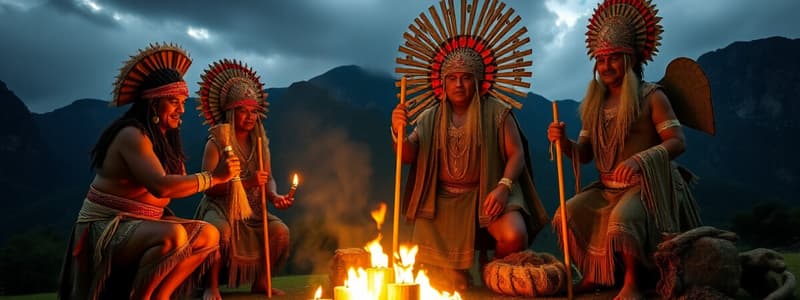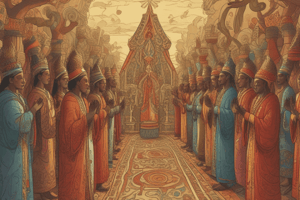Podcast
Questions and Answers
What secret do the frozen bodies found on Andean peaks reveal about the Inca civilization?
What secret do the frozen bodies found on Andean peaks reveal about the Inca civilization?
They suggest that the Inca may have practiced child sacrifice as part of a deadly mountaintop ritual.
Who is Johan Reinhard and what has been his contribution to the study of Andean culture?
Who is Johan Reinhard and what has been his contribution to the study of Andean culture?
Johan Reinhard is an anthropologist who has explored Andean beliefs about mountains for nearly two decades to understand Andean cosmology and religion.
Why was Johan Reinhard unable to return to Sara Sara after his first climb in 1983?
Why was Johan Reinhard unable to return to Sara Sara after his first climb in 1983?
He was prevented from returning due to violent weather and terrorism in the region.
What role do the residents of Quilcata play in Johan Reinhard's expedition?
What role do the residents of Quilcata play in Johan Reinhard's expedition?
What challenges did Johan Reinhard face in excavating the ancient walls he discovered on Sara Sara?
What challenges did Johan Reinhard face in excavating the ancient walls he discovered on Sara Sara?
Flashcards are hidden until you start studying
Study Notes
Ice Mummies
- The Andes mountains hold a dark secret: ancient Incan rituals that involved sacrificing children to appease the mountain gods.
- Anthropologist Johan Reinhard has spent nearly two decades researching these practices and their significance in understanding Andean culture.
- The Incas venerated mountains, believing them to be powerful deities that controlled the weather and could bring life-giving rain.
- The Incas had no written language, so much of what we know about their history comes from Spanish chronicles written after the conquest in the 16th century.
- The chroniclers wrote about a ritual called capa cocha, where the Incas sacrificed children to the mountains.
- The El Plomo boy, a frozen Inca mummy discovered in 1954, provides evidence that capa cocha was a real practice.
- The Incas believed that children were pure and made ideal emissaries to the gods because they had not yet acquired adult sins.
- The El Plomo boy was found adorned with exquisite Inca textiles and jewelry, suggesting he was a carefully chosen sacrifice.
- The Spanish chronicles describe elaborate ceremonies leading up to the sacrifices, where children were paraded across the country to the mountaintops.
- The El Plomo boy's body shows signs of a long journey, such as calloused feet and frostbite, confirming he was alive when he reached the summit.
- In 1995, another capa cocha child, nicknamed Juanita, was discovered on Mount Ampato, providing further evidence of the ritual.
- Johan Reinhard's expedition to the summit of Sara Sara aimed to uncover more evidence of capa cocha practices.
- The team discovered a complex of man-made platforms and stone retaining walls on the summit, indicating the site was used for rituals.
- The team found silver shawl pins on the surface, suggesting that offerings may have been disturbed by looters.
- Looters, called huaqeros, are a major threat to Inca archaeological sites, often taking artifacts and desecrating burial sites.
- They are motivated by the potential to find gold and other valuable artifacts, as well as by superstition.
- Looters destroy valuable evidence and hinder the study of Inca civilization.
- The discovery of the capa cocha children has redefined our understanding of Inca beliefs and practices, particularly the importance of mountain worship and human sacrifice.
Andean Cosmology
- Andean traditions are deeply rooted in the belief that the mountains are living entities with supernatural powers.
- These traditions have survived despite the efforts of Spanish missionaries to eradicate them.
- The locals continue to perform rituals to appease the mountain spirits, seeking their protection and favor.
- The rituals involve offerings, often of llama fetuses, which are believed to be a favorite food of the mountain deities.
- It is through these practices that the locals strive to achieve harmony with the natural world.
Conclusion
- The discovery of ice mummies has offered crucial insights into the world of the Inca and their relationship with the mountains.
- These frozen bodies have preserved not only the physical remains but also a glimpse into the beliefs and practices of a lost civilization.
- However, the ongoing threat of looting continues to endanger the preservation of Inca heritage, emphasizing the need for continued research and protection of these sites.
Inca Child Sacrifices
- The burial sites of Inca children, known as capa cocha, are often located in remote and inaccessible places, motivating grave robbers (huaqueros) to search for gold.
- Dynamite has been used to excavate these sites, resulting in damaged bodies and artifacts.
- The discovery of a partially preserved Inca boy, known as the Aconcagua boy, provides insights into their final moments:
- He was found on Mount Aconcagua, the tallest peak in the Western Hemisphere, in 1985.
- Analysis of his remains revealed he ingested achiote, a red dye symbolizing life, before his death, and possible signs of stress or even fear, possibly due to the nature of the sacrifice.
- The mummy of Juanita, discovered on Mount Ampato, revealed evidence of a violent death:
- She was found in 1995, and initial observations suggested a serene death.
- CAT scans conducted at Johns Hopkins University revealed she suffered a severe blow to the head, likely causing internal bleeding and her death.
- Analysis of her remains holds the potential to provide more insights into her life and the Inca empire she belonged to.
- The discovery of a female capa cocha mummy called Sarita on Mount Sara Sara provided further evidence of the practice:
- She was found in 1997, buried in a partially degraded state due to the non-frozen soil.
- Examination of her remains revealed a shawl pin, indicating she was a girl.
- Like Juanita, she suffered a severe blow to the head.
- Her everyday clothing, unlike the royal garb of other mummies, suggests she may not have been of high social standing, although she was clearly a sacrifice.
- The intricate nature of the grave, with its offerings and textiles, will help archaeologists understand the ancient ritual.
Sara Sara Excavations
- The Inca mountaintop site of Sara Sara is being investigated by a team of archaeologists.
- The site is challenging due to its altitude and weather conditions.
- The team found a series of offerings, including:
- Smaller silver statues
- A gold vicuna figurine
- Seashell miniatures
- Shaw pins
- A silver llama figurine, suggesting the possibility of a human sacrifice nearby
- These artifacts suggest the site was a place of great religious significance for the Incas.
- While the main platform yielded mostly grass and ice, a smaller platform uncovered several more artifacts, including seven in total.
The Discovery of Sarita
- In 1997, the archaeological team discovered Sarita, a young capa cocha girl, buried in a partially degraded state.
- The discovery was made in the eastern terraces of the site, where the ground is not frozen.
- The team will now focus on analyzing her remains and the associated offerings to better understand the practice of Inca child sacrifice.
- The team is hopeful that further investigation will unlock more secrets about the dark mysteries of capa cocha.
Studying That Suits You
Use AI to generate personalized quizzes and flashcards to suit your learning preferences.




